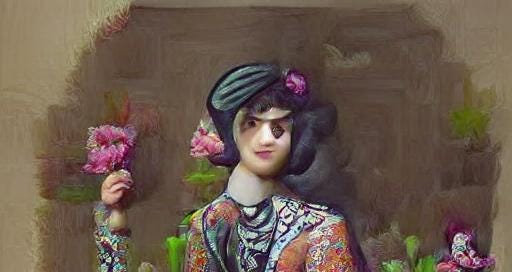Quantum Digital Art Season 1 Artist Interview: Morehshin Allahyari
We sat down with Morehshin Allahyari to learn more about her upcoming drop:ماهطلعت Moon-faced
Morehshin Allahyari (Persian: موره شین اللهیاری), is a NY based Iranian-Kurdish artist who uses 3D simulation, video, sculpture, and digital fabrication as tools to re-figure myth and history. Through archival practices and storytelling, her work weaves complex counternarratives in opposition to the lasting influence of Western technological colonialism in the context of SWANA (Southwest Asia and North Africa).
For“ماه طلعت Moon-faced”, Allahyari uses a carefully researched and chosen series of keywords with a multimodal AI model to generate a series of videos from the Qajar Dynasty painting archive (1786-1925). Through this collaboration, the machine program learns to paint new genderless portraits, in the effort to undo and repair a history of Westernization that ended the course of nonbinary gender representation in the Persian visual culture. In ancient Persian literature, ماه طلعت (Moon-faced) was a genderless adjective used to define beauty in both men and women. In contemporary Iran, it refers to the beauty of women only.
We were able to hear from Morehshin Allahyari about her influences, art process, and the inspiration for ماه طلعت Moon-faced. These 14 pieces, combining an ai process and art from the Qajar Dynasty are now available on Opensea.
Quantum
Who have been your biggest artistic influences, and why?
Morehshin Allahyari
I think I have always been the most inspired by those artists, writers, poets, and thinkers who are world-builders; who break some kind of boundaries, push some kind of limits, ask unasked questions, and make something invisible visible. This can present itself as a form/medium, or concept, or visual elements, or theory.
Quantum
What was the process of creating the artwork for this collection?
Morehshin Allahyari
For the Moon-faced series, I use a multimodal AI process, which includes text prompts and VQGAN + CLIP libraries. This process involves a deep understanding of how the generated image, responds to certain keywords, and definitions. Obviously, as you work longer with this process, you get to understand the biases and stereotypes built into these AI systems. The most exciting part of creating this series for me has been to really find and try to work around that when possible.
Quantum
Precisely what is it you want to say with this collection, and how do you get your artwork to say that?
Morehshin Allahyari
In ancient Persian literature, ماه طلعت (Moon-faced) was a genderless adjective used to define beauty in both men and women. In contemporary Iran, it refers to the beauty of women only. Something similar happened, in the world of images, to the Qajar dynasty portrait paintings: the modernization of Iran, the influence of the European tradition of realistic painting, and the use of camera technology and therefore photography as a model, overshadowed and ended the queer representation of genders that historically characterized these paintings, largely known for their gender-undifferentiation. In my Moon-faced/ماه طلعت series, the machine program learns to paint new genderless portraits, in the effort to undo and repair a history of Westernization that ended the course of nonbinary gender representation in the Qajar Dynasty painting archive (1786-1925).
Quantum
How did you first encounter NFTs and Cryptoart, and when did it click for you that there was a lot of potential here?
Morehshin Allahyari
I think I first came across NFT’s and Cryptoart in 2020. As a new media artist who has been active in the field of art and technology for the past decade, I see NFTs similar to any other technological forms and tools that have the potential for creating something critical and poetic. I don’t think it’s different than any other tool, except that there is now suddenly a market for digital media artists in a way that was not available or possible before. I am of course still skeptical about its true potential for artists who make political or critical work, but I am curious to see how it might all unfold.
Check out Morehshin Allahyari Artist Journal on our YouTube channel to learn more about her.
Artist Socials:







